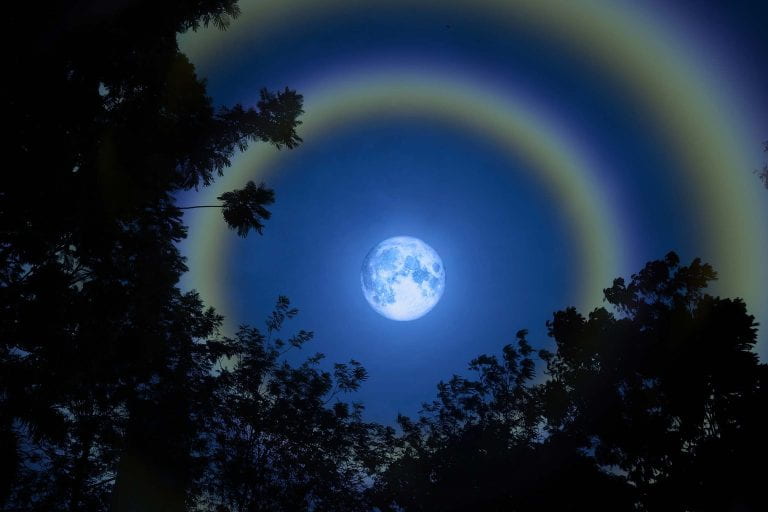Moonbows: What's a lunar rainbow?
In the late 1700s, English poet William Cole put his description of a moonbow into verse:
The atmosphere with humid vapors flow / And the Moon displays her lunar bow.Scientifically speaking though, moonbows, also known as “lunar rainbows,” occur when moonlight shines on water droplets. As the light passes through the droplet, it refracts off the back of the droplet and exits the droplet after bending a second time. This bending of light causes it to split into its individual color wavelengths of red, orange, yellow, green, blue, indigo, and violet.
But moonbows are more rare than rainbows — this phenomenon occurs only when the Moon is very low (for nerds, no more than 42 degrees above the horizon), the sky is dark, and the rain is falling opposite the moon. As displayed by the image above, they usually look spooky-white rather than the famous, well-known set of rainbow colors. Fascinatingly, all of the colors of the spectrum are actually present in a moonbow; however, because moonlight is far less intense than sunlight, the naked eye has can’t detect these various colors in the moonlight, meaning we see more of a “white” rainbow per se (i.e., white being the combination of all of light’s visible colors). (If you’re a photographer, however, the colors of a moonbow will show up in long exposures or on high-speed film.) The size of a moonbow depends on the moon’s height in the sky: the lower the moon, the bigger the moonbow. Typically, the largest moonbows occur when the Moon is within only an hour of rising or setting and is at its brightest and fullest.
Generally, one will always spot a moonbow near a waterfall, creating a thin layer of mist and making the sighting of a moonbow possible. One of the most revered places to witness a moonbow is the Victoria Falls in Zimbabwe. One can enter via the Zambian or the Zimbabwean rain forest during a full moon. Every time during the full Moon, the rainforest opens its doors for a special tour during the evening for travellers to witness the moonbow. Niagara Falls also was once home to this unique phenomenon, but now due to development of the surrounding areas, it has created light pollution and moonbows are no longer visible there anymore. There are other places also where one can witness this phenomenon, including the Wallaman Falls in Australia, the Yosemite Falls in California, the Kihei Falls in Hawaii, and amidst other places. And the best time to witness the phenomenon is during the months of June, July and August.
Lunar halos are other circles of light around the Moon. But don’t be mistaken — moonbows and lunar halos aren’t the same thing! While halos are also created when moonlight refracts off of water droplets in the atmosphere, this water is in the form of frozen ice crystals in cirrus clouds, not liquid droplets. Another difference between the two is that a halo creates a ring around the Moon while the center of a moonbow’s arc appears in the direction opposite of the Moon.
Grovier, Kelly. “The Rare Phenomenon of the ‘Moonbow’.” BBC Culture, BBC, 24 Feb. 2022, https://www.bbc.com/culture/article/20161021-the-rare-phenomenon-of-the-moonbow.

Enjoy Reading This Article?
Here are some more articles you might like to read next: